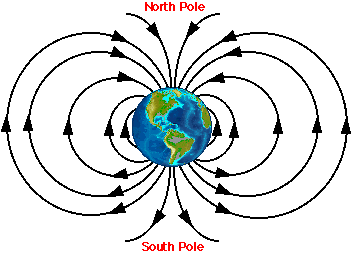
Earth's magnetic field as it is today. Like a bar magnet, the field lines run from the south pole to the north pole. But in the past it has also been reversed, so that field lines ran from north to south. It has flip-flopped between these two configurations for millions of years.
To make sense of this, scientists needed another clue.
The Earth's magnetic field is just like that of a bar magnet, with field lines running from the south pole to the north pole. A compass will follow these field lines and always point north.[1]
But this hasn't always been the case. We can measure the past magnetic field of the Earth using basalt. Basalt is a volcanic rock that also happens to contain a magnetic mineral called magnetite.[2] Basalt comes to the surface as a liquid and then as it cools solid, its magnetic crystals line up parallel to the Earth's magnetic field, leaving a permanent record of the field's orientation.[3]
By looking at ancient basalts on land, scientists were surprised to find that as recently as 780,000 years ago the magnetic field was exactly opposite to what it is today. All compasses would have pointed to the south, aligning with the field lines that, at that time, ran from the north pole to the south. Furthermore, over millions of years the magnetic field has been flip-flopping back and forth between its current orientation, known as "normal polarity" and its opposite, known as "reversed polarity".[4]
See Wikipedia: Geomagnetic reversal.
Motonori Matuyama discovered in the 1920s that the magnetic field of the Earth has pointed in the opposite direction in the past. He discovered this when studying volcanic basalt laid down in Japan.
Evidence that supported this and showed that the field had been flip-flopping over millions of years accumulated in the following decades. In the 1960s it was even possible to date these reversals accurately, using argon gas samples from the basalt.
A compass will always point north except at the poles, where it has no definite direction.
Above the Curie temperature (around 500 degrees Celsius for basalt), the magnetic spins are aligned randomly. But as they cool, their lowest energy state is with all spins aligned in a direction determined by the ambient external magnetic field. See picture here.
[This is an example of spontaneous symmetry breaking, which often appears in physics. It is important, for example, in the Higgs mechanism.]
The most recent reversal 780,000 years ago was the Brunhes-Matuyama reversal. The average interval between reversals is roughly 200,000 to 300,000 years (figures from Wikipedia).
The field's origin is believed to be the spinning liquid iron core of the Earth.
Motonori Matuyama, "On the Direction of Magnetization of Basalt", (1929).
Author: Tom Brown
Copyright: public domain
Date last modified: 7th Oct 2011
Peer-review status: Not yet peer-reviewed
http://www.unc.edu/depts/oceanweb/turtles/geomag.html